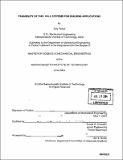Feasibility of fuel cell systems for building applications
Author(s)
Tarud, Sofy, 1980-
DownloadFull printable version (17.15Mb)
Other Contributors
Massachusetts Institute of Technology. Dept. of Mechanical Engineering.
Advisor
Ernest G. Cravalho.
Terms of use
Metadata
Show full item recordAbstract
Worldwide electricity consumption will nearly double between 2001 and 2025 but the projects to increase electricity production and transport will not be enough to fulfill the demand. In the future, most of the power demand will be produced by Distributed Generation (DG) systems. DG refers to power generating technologies independent from the electrical grid, located at or near the location where electricity is consumed. Fuel Cells have become very attractive DG systems in recent years, however, Fuel Cells are still in their early stages of deployment and the advantages and disadvantages of such systems for commercial applications are unclear. A study to learn how Fuel Cells perform in commercial buildings was conducted. To compare the effectiveness of fuel cells to other prime movers the study looked at Phosphoric Acid and Molten Carbonate Fuel Cells, microturbines, and lean burning reciprocating engines. First, the hotel's natural gas and electricity load data was analyzed to understand the requirements and adequately size the DG systems. After, the economics and efficiency of the plant was looked at with and without opportunity for cogeneration. Finally, a sensibility analysis was conducted to assess the variability of the plant's savings if some of the assumed parameters changed PAFC and MCFC, in baseload operation, with and without an absorption chiller are both very attractive technologies for a DG installation at the hotel if initial capital costs are reduced. The initial capital investment of fuel cells can and should be reduced, either by government and/or utility incentives or decreases in costs due to economies of scale.
Description
Thesis (S.M.)--Massachusetts Institute of Technology, Dept. of Mechanical Engineering, 2004. Includes bibliographical references (p. 109-110).
Date issued
2004Department
Massachusetts Institute of Technology. Department of Mechanical EngineeringPublisher
Massachusetts Institute of Technology
Keywords
Mechanical Engineering.